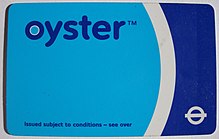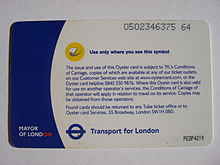Oyster card
The Oyster Card (literally: "Auster card") is an electronic ticket equipped with a Mifare - RFID chip, introduced in 2003 and used in public transport in the City of London and in the National Rail in Greater London . As of June 2012, more than 43 million Oyster Cards had been issued. More than 80% of all trips were made with an Oyster card at this point in time. Since 2014, contactless Mastercard , VISA , American Express and Maestro cards can be used as part of the “Future Ticketing Program” of Transport for London like Oyster cards for pay-as-you-go. Transport for London is the first transport operator in the world to accept contactless payments in this form and the spread of contactless payment in London is attributed to this fact. Transport for London is one of the largest contactless payment acceptance points, with every 10th contactless payment in the UK being made on the Transport for London network.
Acquisition and return
The Oyster Card can be purchased at most train stations, shops and special machines for a deposit of five pounds . It can be returned to the point of sale and the deposit and any remaining balance (less than ten pounds) will then be paid out.
use
In the pay-as-you-go variant or when a 7-day travel card (weekly card ) is loaded, it is registration-free and transferable. For monthly or annual tickets, the Oyster Card must be registered by entering personal data and is personal. In principle, the routes traveled, as well as credit and debit charges, are saved and can be assigned to the respective person when registering.
variants
Pay-as-you-go prepaid card
The credit of the card can be topped up at machines at train stations or at underground stations. There is also the option of defining a threshold value below which an automatic transfer from a bank account or credit card takes place ( auto top up ). Credit can also be purchased over the Internet, which for security reasons is only activated after entering a station of your choice in advance.
When traveling on city buses and on the tram in Croydon, the card is held up to a card reader when boarding and the same amount for a bus journey is charged.
When traveling on the National Rail , Underground , Overground or DLR , the card must not only be held up to a reader when entering the station, but also when leaving the station. As a result, the fare is determined based on the start and destination stations according to a zone model in which the inner city forms zone 1 and eight further zones are each in a ring around the next lower zone. If a destination station has no blockage (e.g. outside the city center), the card still has to be "checked out" when leaving, otherwise the fare for the theoretically longest possible route will be charged.
The so-called price-capping rule applies to the pay-as-you-go procedure , according to which you are charged a maximum of the price of a one-day travelcard (day ticket) for any number of trips made using any means of transport .
Season tickets Travelcards
In addition to the pay-as-you-go procedure, weekly, monthly and annual tickets can also be loaded onto the Oyster Card. This is a cheaper offer than single journeys and is particularly profitable for commuters .
Tourist Card Visitor Oyster Card
At the end of 2007, the unlimited valid and non-personalized Visitor Oyster Card with limited functions was introduced for tourists . This can only be used with pay-as-you-go , travel cards, online top -ups and auto top up are not possible. The Visitor Oyster Card is described in a German-language brochure, which is available as a PDF file. Some discounts and specials are available with a Visitor Oyster Card .
purchase
The Visitor Oyster Card must be ordered from abroad via the Transport for London ( TfL ) webshop and will be sent by post for a fee. The activation fee of five pounds, unlike the deposit on the regular Oyster Card, is non-refundable.
Airport
The Oyster Card can be used for London City Airport , Heathrow Airport and Gatwick Airport . The Oyster Card is not valid at Luton Airport or Stansted Airport .
Daily maximum
The daily maximum amount ( price capping ) depends on the zones used.
Gatwick Airport is served by three rail companies, Southern , Thameslink and Gatwick Express . Traveling with Southern and Thameslink are the price capping count, with Gatwick Express is not.
Charging
The credit can be topped up with cash or credit card at machines at most underground stations, in the Oyster ticket stops or visitor centers .
Children from 11 to 15 years
For children from 11 to 15 years of age, the children's rate (Young Visitor Discount) can be activated at most subway stations and visitor centers . The child rate is around half of the adult rate and is valid for 14 days.
refund
Any remaining balance up to ten pounds will be refunded. The refund will be made:
- In person at the machines at the underground stations
- In one of the visitor centers, except in Gatwick
- By post. The card will be sent to TfL Customer Services, 4th Floor, 14 Pier Walk, London, United Kingdom with a refund request and personal details .
- By paying phone on +44 343 222 1234
Visitor Pass tourist card
The Visitor Pass is an impersonal card for public transport in London. The card is redeemed for two or three days and covers zones 1 to 6. The tickets for children aged 11 to 15 are discounted. Time is regarded Visitor Pass while the o ff-peak times ( off-peak ). It starts Monday to Friday after 9:30 a.m. There are no peak times on Saturday and Sunday .
The card can be purchased at underground stations and visitor centers. In contrast to the Oyster Card , the Visitor Pass is not valid for National Rail , Emirates Air Line (cable car) or River Bus .
60+ London Oyster photocard
Seniors aged 60 and over who live in London receive an Oyster Card for a one-time issuance fee of £ 20, which they can use for free (e.g. bus, tram, underground) or reduced (e.g. Emirates Air Line) trips entitled.
Naming
Transport for London entrusted Appella with the naming. According to the information on their homepage on the “Oyster Card” project, the decision was made to use this name, on the one hand to emphasize the secure payment method ('protected like a pearl in an oyster') and on the other hand to use the common English phrase “The world is yours Auster ”.
Others
- At the end of 2007 a card with an advertising print of the Tutankhamun exhibition presented in London was issued in limited numbers.
- In the spring of 2011, Transport for London issued a limited number with a motif for the wedding of Prince William and Catherine Middleton .
- In mid-May 2012, a limited edition of 250,000 was published on the occasion of Queen Elizabeth II's diamond jubilee .
- The Oyster Card is not compatible with the ITSO smart card system , which has been introduced in other regions of Great Britain for cashless payments in local public transport and which corresponds to the VDV core application in Germany.
Web links
- Official website
- Webshop Visitor Oyster Card
Individual evidence
- ↑ http://www.tfl.gov.uk/corporate/media/newscentre/archive/24243.aspx
- ^ Projects and Planning Panel, Project Monitoring papers . Transport for London. January 9, 2014. Retrieved January 3, 2014.
- ↑ London's contactless fares system to power New York's subway, bus and rail journeys (en-GB) . In: MayorWatch , October 25, 2017.
- ^ Transport for London | Every Journey Matters: Licensing London's contactless ticketing system ( en )
- ^ Transport for London: Visitor Oyster card. Retrieved September 11, 2018 .
- ↑ a b Transport for London: Visitor Oyster card brochure. Retrieved September 11, 2018 .
- ↑ Special offers. Transport for London, accessed July 14, 2016 .
- ↑ Visitor Oyster Card | TfL Visitor Shop. Retrieved September 11, 2018 .
- ^ Transport for London: Oyster ticket stops. Retrieved September 11, 2018 .
- ↑ a b c d Transport for London: Visitor Centers. Retrieved September 11, 2018 .
- ^ Transport for London: Visitor Oyster card - Traveling with Children. Retrieved September 11, 2018 .
- ^ Transport for London: Maps. Retrieved September 11, 2018 .
- ↑ Transport for London: Tube (underground stations). Retrieved September 11, 2018 .
- ↑ Transport for London: River fares. Retrieved September 11, 2018 .
- ↑ https://tfl.gov.uk/fares/free-and-discounted-travel/60-plus-oyster-photocard
- ^ Homepage of the Apella company, "Easter Case Study", accessed on October 14, 2019.
- ↑ http://www.itso.org.uk/


